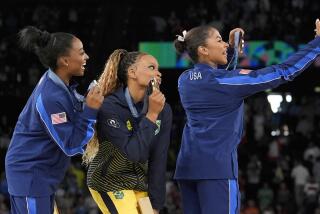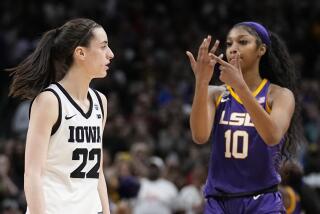How Gender Affects the Risk of Injury
- Share via
WASHINGTON — Many theories--nearly all of them controversial--have been put forth to account for women’s disproportionate knee-blowout rate. Most researchers suspect that several factors interact in complex ways to produce greater vulnerability to injury.
One of those factors may be women’s hormonal fluctuations. In some studies, higher anterior cruciate ligament (ACL) tear rates coincided with women’s premenstrual spikes in estrogen levels. Though the mechanism is unclear, some researchers speculate that estrogen weakens the ligament by relaxing soft tissue and slowing collagen synthesis.
Perhaps women could protect themselves from injury by taking estrogen-suppressing hormones, some suggested. But the prospect of female athletes’ suppressing menses and risking possible health damage from powerful hormone therapy was so discomfiting that researchers disowned the idea.
“That [suggestion] sent up a red flag--we needed to put a halt to that talk,” said Scott Lephart, director of the neuromuscular research laboratory at the University of Pittsburgh.
Distinctive aspects of female anatomy have also been identified as probable contributing causes of the ACL gender gap.
The wider female pelvis often produces thighs that angle inward, from hip to knee, at a sharper angle than in men. Scientists call that slant the Q-angle, or quadriceps angle. They describe it as a “knock-kneed” appearance that is most noticeable--and dangerous--when the athlete is coming down from a jump. The sharper angle puts stress on the knee ligaments.
Other possible anatomical factors:
* A smaller “intercondylar notch”--the indentation (formed by the two knobs at the end of the femur) through which the ACL passes. A smaller notch means a smaller, weaker ACL.
* Looser joints and less muscle mass in the thighs in proportion to body weight, leading many women to rely more heavily on ligaments than on muscles to stabilize the knee.
Other possible causes being explored range from the choice of footwear to quirks in women’s vestibular system--the parts of the inner ear that control balance.
Some of the most promising work, however, looks at gender differences in neuromuscular patterns. These complex interactions between the brain and the muscles dictate how people move, jump and land, determining which muscles they favor and how quickly these muscles are “recruited.” This research is promising because if these patterns are developmental and not genetic, it may be possible to change them through simple physical training.
Consider these common female tendencies:
* An upright, rather than flexed-knee, game stance. This leads women to hyperextend the knee when they make a quick movement--meaning that the tibia slides forward, potentially snapping the ligament designed to hold it back. The tendency to remain more upright applies to women’s landing technique as well. Lephart studied incoming athletes at the University of Pittsburgh and found that the men flexed their knees much more deeply when landing from a jump--30% on average, compared with 15% for women.
* Inward-wobbling knees. “When a woman pivots or lands on one leg to come down from a rebound, there’s often this inward medial motion, a lack of control of side-to-side movement,” said Timothy E. Hewett, director of applied research at Cincinnati Sportsmedicine Research and Education Foundation. “It’s this tendency to want to let the knee operate like a ball-and-socket joint.”
* The so-called quadriceps/hamstring imbalance. Women rely more on their quads (the muscles in the front of their thighs) to cushion the shock of landing than on their hamstrings (the muscles in the back of their thighs); men do the opposite. Researchers say the male habit is more protective: The quads tend to tighten the ACL, while the hamstrings and other flexor muscles (like the gluteals and the muscles in the back of the calf) take stress away from the ligament.
“We studied high school volleyball athletes, and the males were using their flexors at three times the level the females were,” said Frank R. Noyes, president and medical director of Cincinnati Sports Medicine and Orthopaedic Center.
The pervasiveness of these patterns among women “is really striking,” said Lephart. His group, the Cincinnati researchers and others have been trying to identify female athletes who are more at risk for injury. “In our incoming basketball and soccer athletes in the last two years, out of 50 women we looked at, we only had five that were functioning at the same level, in neuromuscular terms, as men,” he said.
With observations like this, researchers are acutely aware that they are not only tracking a medical mystery but skirting a political minefield. Considering the many anatomical and biomechanical strikes against female athletes, should we be rethinking that tenet of the women’s movement: that girls and women can play sports as intensely and professionally as men and boys? But the new findings on women’s ACL risks, say researchers, don’t prove that women are ill-designed for sports.
“They only mean that our methods of training athletes are more geared to men than women,” said Mary Lloyd Ireland of Kentucky Sports Medicine. “We need to train women and girls in a way that is gender-specific.”






